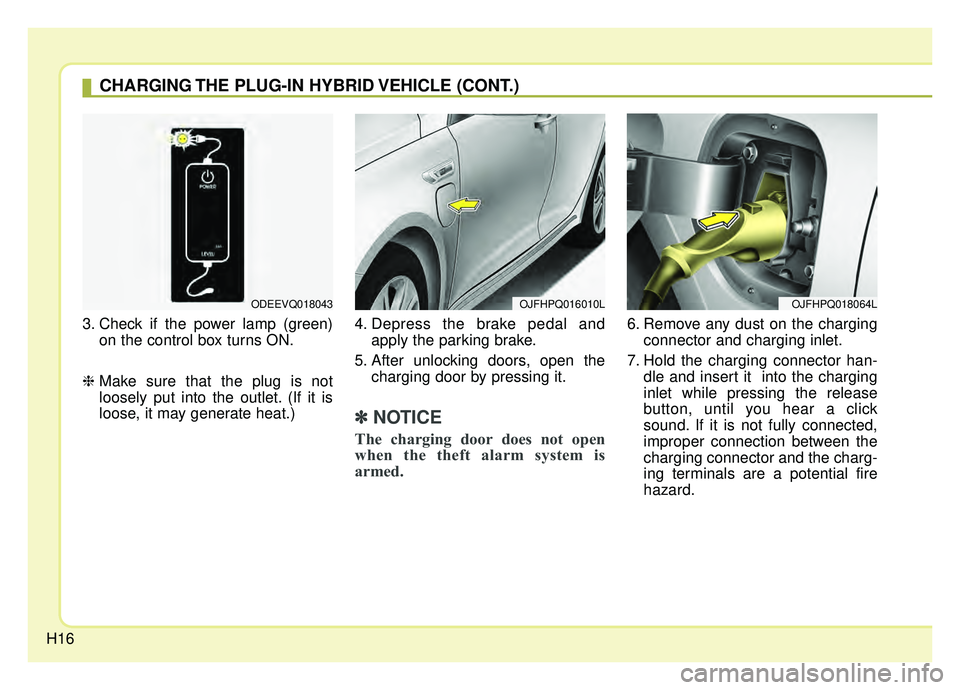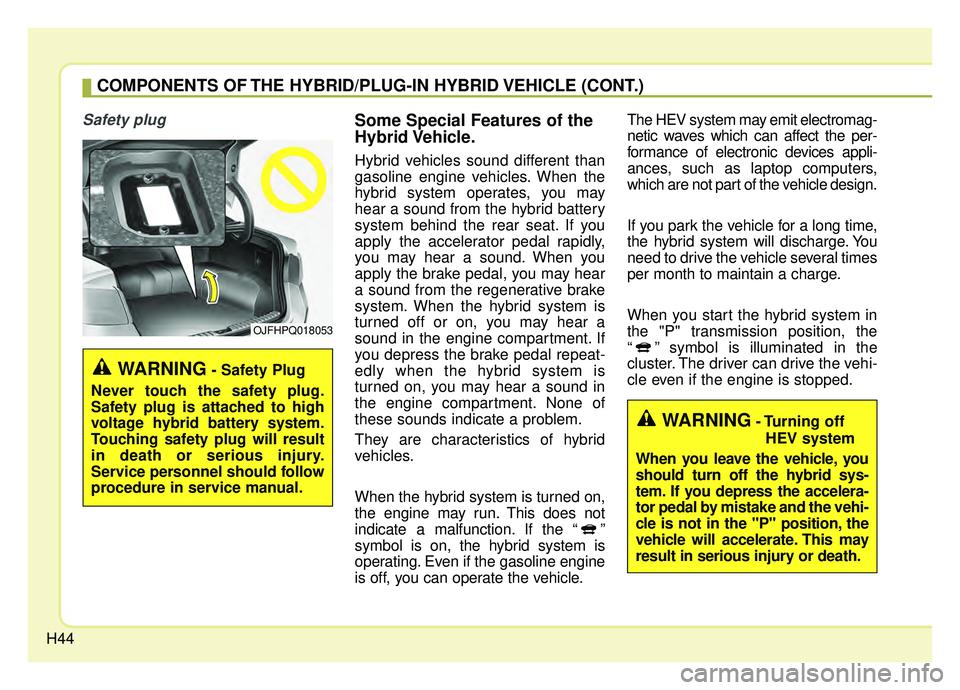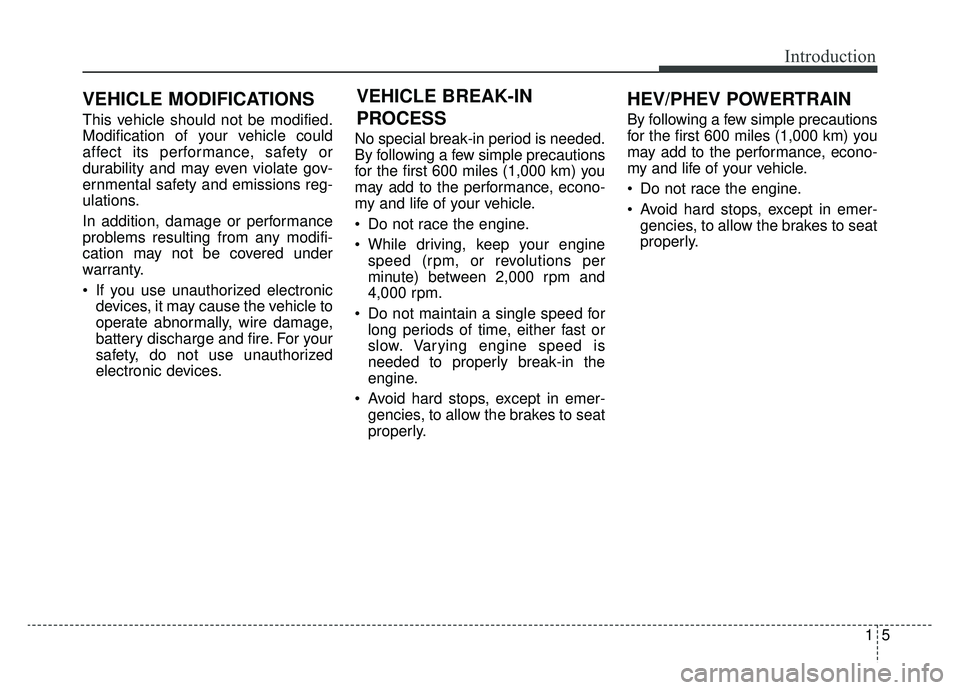brake KIA OPTIMA HYBRID 2020 Owners Manual
[x] Cancel search | Manufacturer: KIA, Model Year: 2020, Model line: OPTIMA HYBRID, Model: KIA OPTIMA HYBRID 2020Pages: 597, PDF Size: 14.2 MB
Page 16 of 597

H9
AC Charge
You can charge your vehicle by plug-
ging into a public charger at a charg-
ing station.
How to Connect to an AC Charger
1. Depress the brake pedal andapply the parking brake.
2. Turn OFF all switches, move the shift lever to P (Park), and turn
OFF the vehicle.
3. After unlocking doors, open the charging door by pressing it.
✽ ✽NOTICE
• The charging door does not open
when the theft alarm system is
armed.
• To open the charging inlet cover, all vehicle doors must be
unlocked. When the doors are
locked, the charging inlet cover
will not open.
OJFHPQ016010L
OJFHPQ016021L
OAEEQ016028
■ AC Charger
■ AC Charger cable
Page 23 of 597

H16
3. Check if the power lamp (green)on the control box turns ON.
❈ Make sure that the plug is not
loosely put into the outlet. (If it is
loose, it may generate heat.) 4. Depress the brake pedal and
apply the parking brake.
5. After unlocking doors, open the charging door by pressing it.
✽ ✽NOTICE
The charging door does not open
when the theft alarm system is
armed.
6. Remove any dust on the charging
connector and charging inlet.
7. Hold the charging connector han- dle and insert it into the charging
inlet while pressing the release
button, until you hear a click
sound. If it is not fully connected,
improper connection between the
charging connector and the charg-
ing terminals are a potential fire
hazard.
OJFHPQ016010L
CHARGING THE PLUG-IN HYBRID VEHICLE (CONT.)
ODEEVQ018043OJFHPQ018064L
Page 41 of 597

H34
Regeneration
Hybrid battery is being charged by
regenerative braking.
(Wheel \bBattery)
Engine Brake
The vehicle is slowed down by
engine compression.
(Wheel \bEngine)
Power Reserve
Engine is both driving the vehicle
and charging the hybrid battery.
(Engine \b Wheel & Battery)
OJFHPQ018050LOJFHPQ018048LOJFHPQ018047L
ENERGY FLOW HYBRID/PLUG-IN HYBRID VEHICLE (CONT.)
Page 42 of 597

H35
Engine Generation/Motor Drive
The vehicle is being slowed by engine
compression and regenerative brak-
ing. The hybrid battery is being
charged by regenerative braking.
(Engine \bBattery \bWheel)
Engine Generation/Regeneration
The engine and regenerative brake
system charge up the high-voltage
battery.
(Engine & Wheel \b Battery)
Engine Brake/Regeneration
The engine compression can be
used to slow down the vehicle. The
regenerative braking system can be
used to charge the hybrid system.
(Wheel \bEngine & Battery)
OJFHPQ018051LOJFHPQ018052LOJFHPQ018049L
Page 45 of 597

H38
Starting the Hybrid System
1. Carry the smart key into the vehi-cle.
2. Make sure the parking brake is firmly applied.
3. Place the shift lever in the P(Park) position. In N (neutral) position,
you cannot start the vehicle.
4. Depress the brake pedal.
5. Press the engine start/stop button.
6. The engine should be started with- out pressing the accelerator. In
extremely cold weather or after the
vehicle has not been operated for
several days, let the engine warm
up without depressing the accelera-
tor.
vehicle, if it is far away from you,
the engine may not start.
ton is in the ACC or ON position
and if any door is open, the sys-
tem checks for the smart key. If
the smart key is not in the vehicle,
the warning, “Key is not in vehi-
cle” will come on, and if all doors
are closed, the chime will also
sound for about 5 seconds. Keep
the smart key in the vehicle when
using the ACC position or if the
vehicle engine is on. The indica-
tor will turn off while the vehicle is
moving. If the starting procedure is fol-
lowed, the “ ” symbol on the
instrument cluster will turn on.
For more details, Please check
chapter 5.
STARTING THE HYBRID/PLUG-IN HYBRID VEHICLE (SMART KEY)
Page 46 of 597

H39
ECONOMICAL and SAFE
OPERATION of Hybrid system
Drive smoothly. Accelerate at amoderate rate and maintain a
steady cruising speed. Don't make
“jack-rabbit” starts. Don't race
between stoplights.
Avoid heavy traffic whenever pos-
sible. Always maintain a safe dis-
tance from other vehicles so you
can avoid unnecessary braking.
This also reduces brake wear.
The regenerative brake generates energy when the vehicle deceler-
ates.
When the hybrid battery power is low, the hybrid system automatical-
ly recharges the hybrid battery.
When the engine runs in “N” posi- tion, the hybrid system cannot gen-
erate electricity. The hybrid battery
cannot recharge in “N” position.
Please refer to chapter 5.
✽ ✽ NOTICE
When the hybrid system is in
READY mode, the engine will auto-
matically start and stop as needed.
The “ ” symbol will illuminate in
the cluster when the system is oper-
ational.
CAUTION- Extended
cranking
Do not crank the engine for aprolonged period of time with-out the engine starting. Thiscould result in damage to theHEV battery and become totallydischarged.
Page 47 of 597

H40
COMPONENTS OF THE HYBRID/PLUG-IN HYBRID VEHICLE
1. Engine : 2.0L
2. Motor : 38kW (Hybrid) / 50kW (Plug-in hybrid)
3. Transmission : 6AT
4. Hybrid starter generator (HSG)5. HPCU (Hybrid Power Control Unit)
6. High voltage battery system
7. Regenerative brake system
8. Virtual Engine Sound System (VESS)
OJFHPQ018001N❈
The actual shape may differ from the illustration.
- PHEV - HEV
Page 51 of 597

H44
COMPONENTS OF THE HYBRID/PLUG-IN HYBRID VEHICLE (CONT.)
Safety plugSome Special Features of the
Hybrid Vehicle.
Hybrid vehicles sound different than
gasoline engine vehicles. When the
hybrid system operates, you may
hear a sound from the hybrid battery
system behind the rear seat. If you
apply the accelerator pedal rapidly,
you may hear a sound. When you
apply the brake pedal, you may hear
a sound from the regenerative brake
system. When the hybrid system is
turned off or on, you may hear a
sound in the engine compartment. If
you depress the brake pedal repeat-
edly when the hybrid system is
turned on, you may hear a sound in
the engine compartment. None of
these sounds indicate a problem.
They are characteristics of hybrid
vehicles.
When the hybrid system is turned on,
the engine may run. This does not
indicate a malfunction. If the “ ”
symbol is on, the hybrid system is
operating. Even if the gasoline engine
is off, you can operate the vehicle.The HEV system may emit electromag-
netic waves which can affect the per-
formance of electronic devices appli-
ances, such as laptop computers,
which are not part of the vehicle design.
If you park the vehicle for a long time,
the hybrid system will discharge. You
need to drive the vehicle several times
per month to maintain a charge.
When you start the hybrid system in
the "P" transmission position, the
“ ” symbol is illuminated in the
cluster. The driver can drive the vehi-
cle even if the engine is stopped.
OJFHPQ018053
WARNING- Safety Plug
Never touch the safety plug.
Safety plug is attached to high
voltage hybrid battery system.
Touching safety plug will result
in death or serious injury.
Service personnel should follow
procedure in service manual.
WARNING- Turning off HEV system
When you leave the vehicle, you
should turn off the hybrid sys-
tem. If you depress the accelera-
tor pedal by mistake and the vehi-
cle is not in the "P" position, the
vehicle will accelerate. This may
result in serious injury or death.
Page 54 of 597

H47
If a vehicle accident occurs:
1. Stop the vehicle and shift thetransmission into "P" position. And
then depress the parking brake.
2. Turn off the Hybrid system by pushing the Engine Start/Stop
Button.
3. Step away from the vehicle to a safe place.
4. Call emergency services for help and let them know the vehicle is a
Hybrid vehicle. If an immersion in water occurs:
If your vehicle was flooded and has
soaked carpeting or water on the
flooring, you should not try to start
the Hybrid system. Have the car
towed to an authorized Kia dealer.When the hybrid vehicle shuts
off
When the high voltage battery or 12-
volt battery discharges, or fuel tank is
empty, the hybrid system may not
operate.
If the Hybrid system stops operating
while the vehicle is moving, reduce
the vehicle speed gradually. Pull
your vehicle off the road to a safe
area, and shift the transmission in to
Park (P) position and;
1. Turn on the hazard warning flashers.
2. Set the start button at OFF, and try
to start the Hybrid system by
applying the brake pedal and
pushing the start button.
3. If the Hybrid system will not oper- ate, refer to “EMERGENCY
STARTING” in chapter 6.
Before you try to jump start the vehi-
cle, confirm the fuel level. If the fuel
level is low, add more fuel before
attempting an emergency start.
WARNING
If a submersion in water occurs:
If your vehicle was flooded and
has soaked carpeting or water
on the flooring, you should not
try to start the Hybrid system.
Never touch the high voltage
cables, connectors and pack-
age modules, because an elec-
trical shock may occur causing
injury or death. High Voltage
cables are orange in color.
In this case, have the vehicle be
towed to and inspected by an
authorized Kia dealer.
Page 60 of 597

15
Introduction
This vehicle should not be modified.
Modification of your vehicle could
affect its performance, safety or
durability and may even violate gov-
ernmental safety and emissions reg-
ulations.
In addition, damage or performance
problems resulting from any modifi-
cation may not be covered under
warranty.
If you use unauthorized electronicdevices, it may cause the vehicle to
operate abnormally, wire damage,
battery discharge and fire. For your
safety, do not use unauthorized
electronic devices. No special break-in period is needed.
By following a few simple precautions
for the first 600 miles (1,000 km) you
may add to the performance, econo-
my and life of your vehicle.
Do not race the engine.
While driving, keep your engine
speed (rpm, or revolutions per
minute) between 2,000 rpm and
4,000 rpm.
Do not maintain a single speed for long periods of time, either fast or
slow. Varying engine speed is
needed to properly break-in the
engine.
Avoid hard stops, except in emer- gencies, to allow the brakes to seat
properly. By following a few simple precautions
for the first 600 miles (1,000 km) you
may add to the performance, econo-
my and life of your vehicle.
Do not race the engine.
Avoid hard stops, except in emer-
gencies, to allow the brakes to seat
properly.
VEHICLE BREAK-IN
PROCESS HEV/PHEV POWERTRAIN
VEHICLE MODIFICATIONS